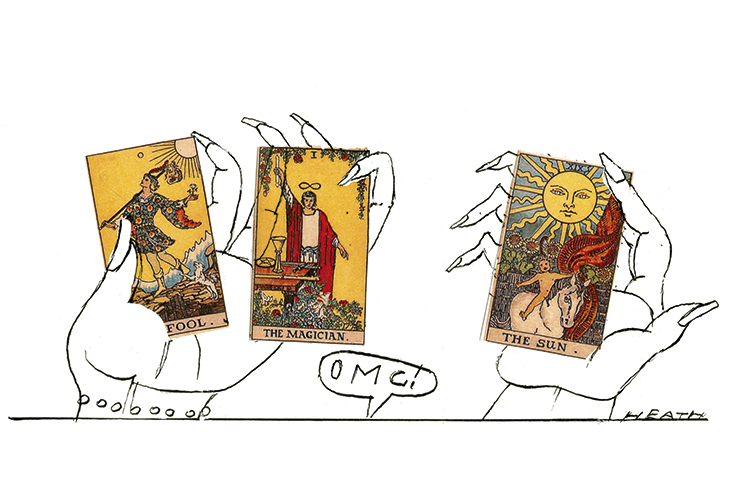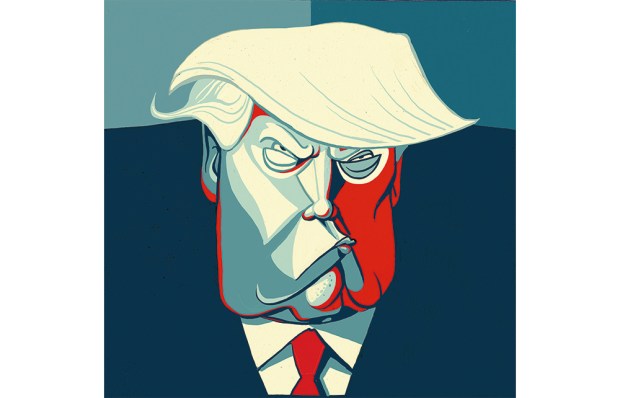I first met a tarot reader in a hotel lobby in central London on my birthday four years ago. I was a book critic at the time and was aware that the cards had inspired writers from W.B. Yeats to T.S. Eliot and Italo Calvino — perhaps there’s a novel in this, I thought. This was serious research. I was less interested in my destiny than I was in the way tarot worked.
That was just as well because no sooner had I sat down than my reader piped up: ‘This has been an especially trying time for you and I’m afraid that it isn’t going to get easier.’ She went on, at length, before I told her there wasn’t a great deal of drama in my life: I had a stable relationship, a good job, family and friends who supported me. Was she confusing my past with my present? She was unrelenting: no, I was about to encounter the lowest point in my life and should be prepared for trouble ahead.
Happy birthday to me. I could have got more wisdom communing with the spirits cabinet. It may not have been the most cheering (or cheapest) of experiences, yet a few days later I couldn’t get the reading out of my head. It wasn’t because of what was said but because of the cards themselves. On the table were mythical images, threaded with Christian and pagan symbolism that drew me into a world of kings and queens, hanged men, magicians, devils and women who tame lions. Plots, characters, actions — my reading may not have been particularly accurate but this mythic world was captivating.
There was a power that stuck with me in the reading: stripped of the fortune-telling, what this reader was doing was telling me a story about my life and placing me at the centre of it. We all tell ourselves stories to understand and cope with the challenges we face, and the tarot simply offered another means to do so. How fascinating that many of the age-old tropes, characters and troubles we confront could be distilled into a 78-card deck. I was hooked.
Whatever your opinion of the tarot, there is little doubt that the cards are having a moment. US Games Systems, which owns the rights to more than 140 tarot decks, claims that sales are at an all-time high. And you don’t need to go to occult stores to buy tarot decks any more: you’ll find them for sale on the high street. Tarot has been appropriated by many as a ‘wellness’ tool. For a while, it seemed like every other person I met was a yoga teacher — these days, the same could be said for tarot readers and astrologers.
But to reduce tarot down to a wellness trend is to ignore the sheer range of ways the cards are being used. In literature, tarot has inspired the plots of Ruth Ware’s thriller The Death of Mrs Westaway and E.V. Harte’s (aka Daisy Waugh’s) Dolly Greene series, while the novelist David Keenan collaborated with the artist Sophy Holling-ton on a psychedelic new tarot deck. On YouTube you’ll find Alejandro Jodorowsky, the 90-year-old Chilean film-maker responsible for El Topo (1970), The Holy Mountain (1973) and the infamous Dune film project, uploading regular videos in which he uses tarot readings to answer questions as diverse as ‘How can I learn to trust my intuition?’ — fairly standard tarot fare — to ‘How can I understand the language of plants?’ or ‘How can I cure my eczema?’ And all this time you had been using creams.
Then there’s my own peculiar pursuit: after that strange encounter at the hotel, I decided I’d train to become a tarot reader with my best friend. We had an ulterior motive for our new-found skills: for the past year, Jennifer Cownie and I have been touring festivals and bookstores under the moniker Litwitchure, using tarot readings as a way of interviewing authors on stage. We had both worked in the books world for years — Jennifer in publishing, me on the books desk at the Times — and had sat through enough samey-samey author interviews to know that a little mischief might be welcome. Our tarot readings aren’t about us channelling the great beyond but they do give us almost magical powers to get our subjects to open up. Or at the very least, to have some fun on stage.
As my understanding of the nuances of the cards has grown, so too has my appreciation for the people who had a knack for reading them convincingly (and without causing grievous offence). Some readers believe they have psychic gifts. Perhaps they do. My feeling is that they are talented storytellers who can spot a narrative thread and know when to keep pulling at it. When I went out into the world to offer readings to friends, almost everyone loved being read. People enjoy their own story being writ large, and their daily challenges presented as a hero’s necessary struggles. That it ‘works’ shouldn’t come as a surprise: the cards are designed around archetypes. A reading isn’t that different to showing someone ink blots — known as the Rorschach test — and asking them what they see. One person might pull the Devil card and see in it their vices and habits; another might see the devil as a misunderstood character.
Your future cannot be read in a pack of playing cards. I make sure whoever I read for knows that as well. But that doesn’t mean a tarot reading is a scam or doesn’t have value to it. Broken down and stripped of its fortune-teller connotations, a good tarot reading is a novel way of re-examining the present. As the psychoanalyst Carl Jung, who took an interest in the cards, pointed out in a 1933 lecture: ‘We can predict the future, when we know how the present moment evolved from the past.’
It is curious that in our data-driven age, we’re seeing a resurgence of interest in what began life as a Renaissance card game. Google Trends, which summarises the popularity of search queries, reveals that searches for the word ‘tarot’ have been increasing in recent years, with a spike of interest in the US and the UK in 2009, around the time of the financial crisis. There was a resurgence of interest at the start of the 20th century as well: like newspapers, tarot readers seem to do better during times of instability.
There could be something more simple at play here: in an age when we spend countless hours staring at screens (the average person looks at their phone 85 times a day), perhaps we are being drawn to old tools and games that allow us to connect with others.
For me, it comes back to storytelling. There is no type of person who comes for a tarot reading: I’ve read for lawyers, accountants, stay-at-home mums, fashion designers, bikers, advertisers and teachers. None of them was looking for supernatural knowledge: they were all just looking for some structure to their lives.
Got something to add? Join the discussion and comment below.
Get 10 issues for just $10
Subscribe to The Spectator Australia today for the next 10 magazine issues, plus full online access, for just $10.
You might disagree with half of it, but you’ll enjoy reading all of it. Try your first month for free, then just $2 a week for the remainder of your first year.














Comments
Don't miss out
Join the conversation with other Spectator Australia readers. Subscribe to leave a comment.
SUBSCRIBEAlready a subscriber? Log in